
John Fulton Reynolds was a career United States Army officer and a general in the American Civil War. One of the Union Army's most respected senior commanders, he played a key role in committing the Army of the Potomac to the Battle of Gettysburg and was killed at the start of the battle.
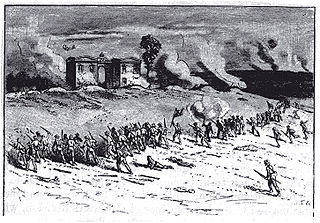
Cemetery Hill is a landform on the Gettysburg Battlefield that was the scene of fighting each day of the Battle of Gettysburg. The northernmost part of the Army of the Potomac defensive "fish-hook" line, the hill is gently sloped and provided a site for American Civil War artillery.

Francis Channing Barlow was a lawyer, politician, and Union General during the American Civil War.

The XI Corps was a corps of the U.S. Army during the American Civil War, best remembered for its involvement in the battles of Chancellorsville and Gettysburg in 1863. The corps was composed primarily of German-American regiments.

Evander McIver Law was an author, teacher, and a Confederate general in the American Civil War.
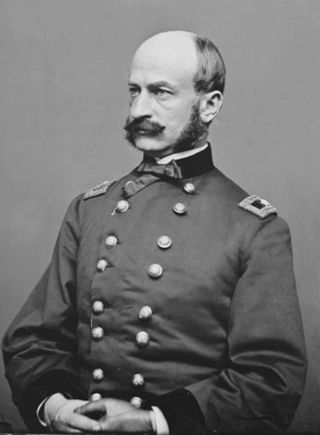
Baron Adolph Wilhelm August Friedrich von Steinwehr was a German-Brunswick army officer who emigrated to the United States, became a geographer, cartographer, and author, and served as a Union general in the American Civil War.

Alfred Iverson Jr. was a lawyer, an officer in the Mexican–American War, a U.S. Army cavalry officer, and a Confederate general in the American Civil War. He served in the 1862–63 campaigns of the Army of Northern Virginia as a regimental and later brigade commander. His career was fatally damaged by a disastrous infantry assault at the first day of the Battle of Gettysburg. General Robert E. Lee removed Iverson from his army and sent him to cavalry duty in Georgia. During the Atlanta Campaign, he achieved a notable success in a cavalry action near Macon, Georgia, capturing Union Army Maj. Gen. George Stoneman and hundreds of his men.
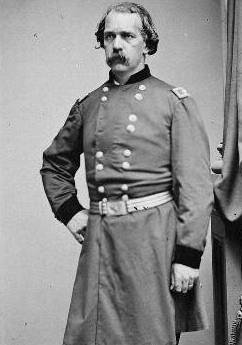
John Henry Hobart Ward was an American soldier who fought in the Mexican–American War and in the American Civil War. Ward joined the army in 1842 and fought in multiple battles in the Mexican–American war, including the Battle of Monterrey, where he was wounded. After leaving the army, he served successively as the assistant commissary general and commissary general for the state of New York. With the outbreak of the American Civil War in 1861, Ward rejoined the army, and became the colonel of the 38th New York Infantry Regiment. Ward and his regiment were engaged in the First Battle of Bull Run and in several battles in the Peninsula campaign. He was promoted to command a brigade after the Battle of Chantilly in September 1862.

The first day of the Battle of Gettysburg during the American Civil War took place on July 1, 1863, and began as an engagement between isolated units of the Army of Northern Virginia under Confederate General Robert E. Lee and the Army of the Potomac under Union Maj. Gen. George G. Meade. It soon escalated into a major battle which culminated in the outnumbered and defeated Union forces retreating to the high ground south of Gettysburg, Pennsylvania.
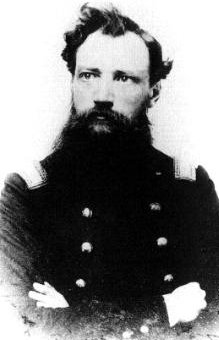
Alexander Schimmelfennig was a Prussian soldier and political revolutionary. After the German revolutions of 1848–1849, he immigrated to the United States, where he served as a Union Army general in the American Civil War.
Orland Smith was a railroad executive and a brigade commander in the Union Army during the American Civil War. In 1863, he led a spirited bayonet charge during the Battle of Wauhatchie that took a significant Confederate position on a hill that now bears his name.
The 75th Ohio Infantry Regiment, sometimes 75th Ohio Volunteer Infantry was an infantry regiment from southwestern Ohio in the Union Army during the American Civil War. It served in the Eastern Theater, most notably in the battles of Chancellorsville and Gettysburg and then in the siege operations against Charleston, South Carolina.
Adolphus (Adolph) Buschbeck commanded the 27th Pennsylvania Infantry in the Army of the Potomac and a brigade in that army and later in the Army of the Cumberland during the American Civil War.

Charles Candy was a career soldier in the United States Army who served as an officer in the volunteer Union Army during the American Civil War. He commanded an Ohio regiment and, frequently, a brigade, during the war, and played a role in the defense of Culp's Hill during the July 1863 Battle of Gettysburg.
Archibald Livingston McDougall was an officer in the Union Army during the American Civil War who commanded the 123rd New York Volunteer Infantry early in the war and subsequently led a brigade at the Battle of Gettysburg.

Ariovistus Pardee Jr. was an officer in the Union Army during the American Civil War. He rose to fame during the Battle of Gettysburg, where he led the defense of a portion of Culp's Hill on July 3, 1863. A monument on the Gettysburg Battlefield commemorates the spot as "Pardee Field."
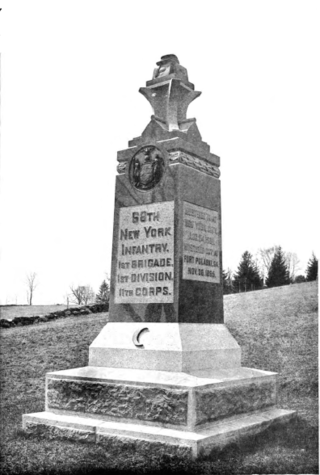
The 68th New York Infantry Regiment served in the Union Army during the American Civil War. Also known as the Cameron Rifles or the Second German Rifle Regiment, the men were mostly German immigrants. Organized in July 1861, three months after the outbreak of war, the 68th saw service in the Eastern and Western theaters.
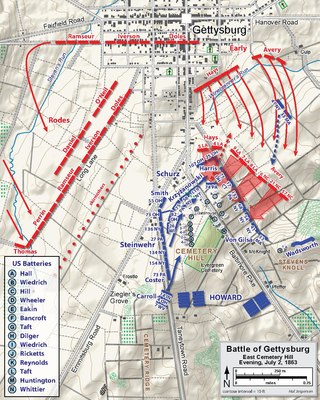
The battle of East Cemetery Hill during the American Civil War was a military engagement on the second day of the Battle of Gettysburg, in which an attack of the Confederacy's Louisiana Tigers Brigade and a brigade led by Colonel Robert Hoke was repelled by the forces of Colonel Andrew L. Harris and Colonel Leopold von Gilsa of the XI Corps, plus reinforcements. The site is on Cemetery Hill's east-northeast slope, east of the summit of the Baltimore Pike.

The 45th New York Infantry Regiment, also known as the 5th German Rifles, was an infantry regiment that served in the Union Army during the American Civil War. It was composed almost entirely of German immigrants. Formed approximately five months after the start of hostilities, the unit's service spanned almost the entirety of the war, and it saw action in several of the war's noteworthy battles, in both the Eastern and Western Theaters.

The 58th New York Infantry Regiment, also called the Polish Legion, was an infantry regiment of United States Volunteers in Union Army service during the American Civil War. The regiment was composed almost entirely of immigrant volunteers: Poles, Germans, Danes, Italians, Russians, and Frenchmen, most of whom were recruited in New York City in 1861.















